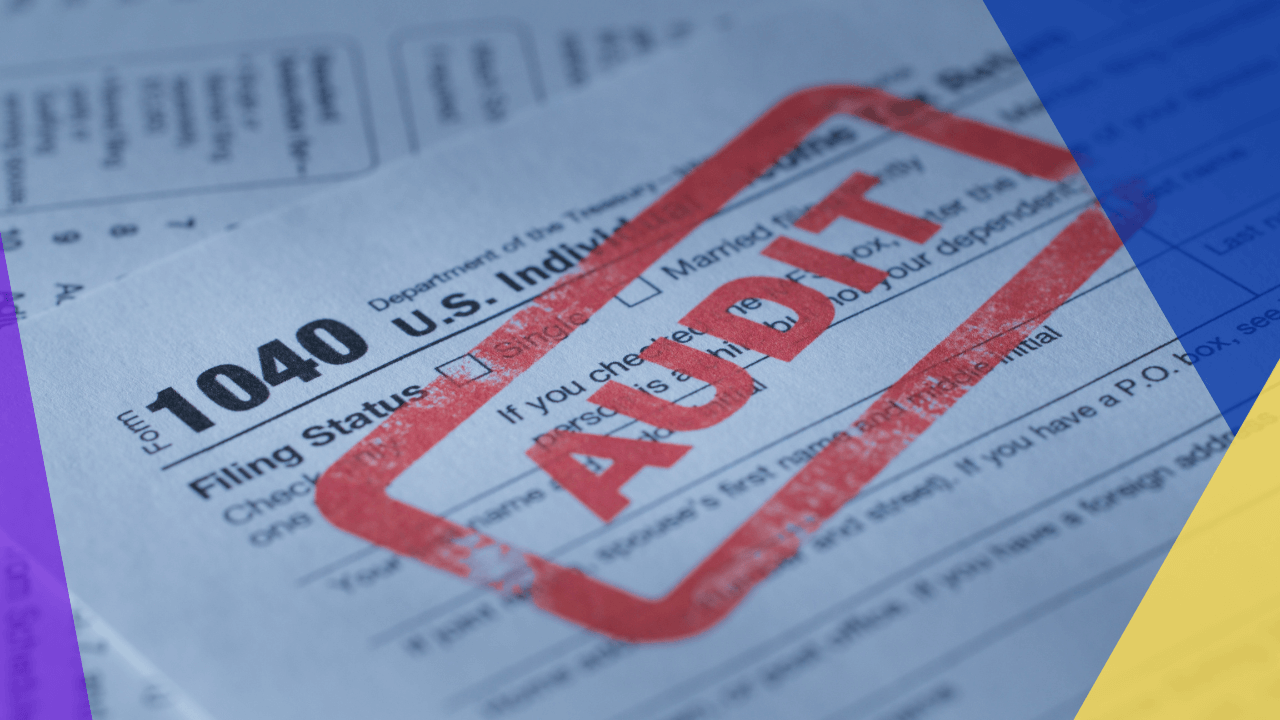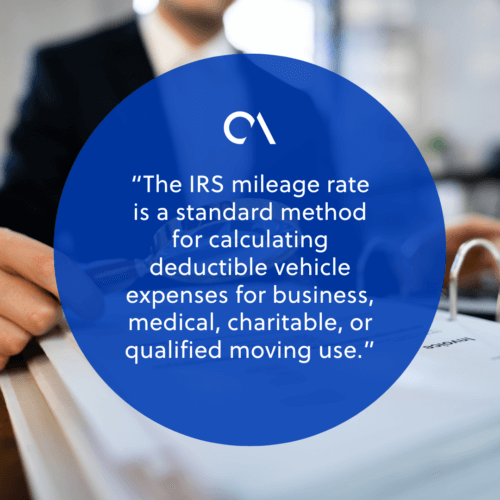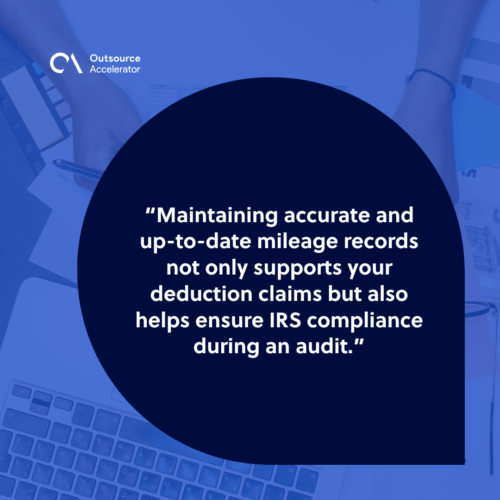Understanding the IRS mileage rate for 2026 to benefit your business

In every business operation, there are additional costs that support effective service delivery and day-to-day operations.
Some costs are for equipment maintenance, meals, and entertainment during meetings, but one of the most common costs is running vehicles for business-related transactions.
That’s why the Internal Revenue Service (IRS) provides guidelines on credits and deductible expenses, including the IRS mileage rate, to help organizations maximize resources effectively.
What is the IRS mileage rate?
The IRS mileage rate is a standard method for calculating deductible vehicle expenses for business, medical, charitable, or qualified moving use.
These rates are updated annually, as shown by the recent increase in the IRS mileage rate for 2026. The updated rate applies to business, charitable, and medical travel.
However, deductions for moving expenses only apply to active-duty Armed Forces members, particularly when relocating under military orders.

How to calculate the IRS mileage rate for 2026
The IRS determines and publishes the standard mileage rates each year, using research on fixed and variable vehicle costs to guide the calculations.
That’s why it’s beneficial for your in-house or outsourced accounting staff to understand the key factors the IRS considers when setting these rates, including:
- IRS consideration:
As mentioned, annual rates are determined based on studies about the operating costs of vehicles. Maintenance, depreciation, and fuel prices are some of the areas of consideration.
- Purpose of operating a vehicle
Deductible costs set by the IRS for the 2026 mileage rate are applicable for those taxpayers who use their vehicles for business, charitable projects, medical, and moving expenses.
The standard mileage rate for business use is not determined based on individual taxpayers’ actual vehicle-related expenses.
Instead, the IRS sets a fixed rate annually based on the average nationwide vehicle operating costs.
Business taxpayers can choose between two methods:
- Standard mileage rate method – A flat rate per mile (e.g., 70 cents per mile in 2026), not tied to the taxpayer’s expenses.
- Actual expense method – Comprises real fuel, maintenance, insurance, and depreciation costs. Deductibles only apply to the business-use portion.
However, if the business uses the actual expense method, only a percentage of total vehicle costs, proportional to business use, can be deducted.
Challenges of IRS mileage rate application
Since the IRS mileage rate is based on national averages, some businesses find it challenging, as it may not cover certain actual expenses they incur, leaving those costs excluded from the deduction.
Factors like insurance rates, maintenance, and fuel prices vary depending on region or state. As a result, some taxpayers may experience over- or under-reimbursement for mileage rate deductions.
That’s why some businesses hire virtual assistants for a short-term engagement to do bookkeeping services and help determine the variable and fixed costs of operating a vehicle.
They help avoid potential errors by performing proper documentation and projecting the possible deductions for their clients.
Qualifications for the business mileage deduction
When evaluating eligibility for the IRS business mileage rate, it’s important to distinguish between general qualification requirements and the specific rules that govern its application.
Here is a quick guide to guide you in applying the IRS mileage rate in 2026:
#1 Purpose of the Business
The primary requirement for qualifying for IRS business mileage rate deductions is having a legitimate business purpose.
To determine this, the IRS considers several factors, including:
- Visiting clients or attending business meetings
- Running business-related errands (e.g., going to a government office or purchasing office supplies)
- Traveling to temporary job sites or project locations
These activities must be directly connected to the operation of your business to qualify for mileage deductions.
#2 Accurate keeping of documentary records
When applying deductions using the IRS mileage rate, maintaining well-documented records of transactions is always an advantage. The IRS also assesses the following records to support the approval of deductions:
- Purpose of the travel
- Date of the travel
- Area or destination
- Number of miles driven
- Details of vehicle ownership or lease
Maintaining accurate and up-to-date mileage records not only supports your deduction claims but also helps ensure IRS compliance during an audit.

#3 Limitations of standard mileage rate:
Limitations on using the standard mileage rate may apply in the following cases:
- The business operates five or more vehicles simultaneously (fleet operations)
- The taxpayer has claimed depreciation methods other than straight-line
- The taxpayer has claimed a Section 179 deduction for the vehicle
- A special depreciation allowance has been taken
- For leased vehicles, once the standard mileage rate is chosen, it must be used for the entire lease term
Deducting business mileage rate based on business structure
The methods and IRS forms in deducting mileage rates for 2026 vary depending on the business structure.
Here are some of the information that can guide you in determining your deductions:
Sole proprietorships and Limited Liability Companies (LLCs)
Sole proprietors and single-member LLCs generally claim mileage deductions by filing Schedule C of IRS Form 1040.
Schedule C includes direct and indirect business expenses, such as vehicle mileage, office supplies, advertising, and other operational costs.
While the mileage deduction isn’t considered a miscellaneous itemized deduction, it is entered on Schedule C as a business-related vehicle expense.
Corporations
Corporations claim IRS mileage deductions using Form 1120 for C corporations or Form 1120-S for S corporations.
Due to additional reporting requirements and the separation between the business and its owners, the process for C and S corporations is generally more complex than for sole proprietors or single-member LLCs.
Corporations can reimburse expenses related to using employees’ vehicles for business purposes through the IRS standard mileage rate and deductible as business expenses.
Partnerships
A partnership reports its income, expenses, and other tax information by filing Form 1065. Deductible vehicle expenses paid by the partnership flow through to the partnership’s tax return.
Partnership income and deductions flow through to the partners, who report them using Schedule K-1 (Form 1065) and enter the details on Schedule E (Form 1040), Part II.
Multi-member LLCs
Multi-member LLCs may be taxed as partnerships, S corporations, or C corporations. They can deduct vehicle expenses using the IRS mileage rate based on their elected tax classification.
As noted earlier, they must follow the appropriate forms and guidelines for their specific tax treatment, Form 1065 for partnerships or Form 1120-S for S corporations.
Maximizing resources with proper monitoring of IRS mileage rate deductibles for 2026
Maximizing resources is one of the fundamental elements for organizations to ensure their sustainability.
Tax deductions, including the IRS mileage rate for 2026, are among the benefits available to businesses regardless of their structure.
Applying mileage rate deductions should be done strategically, with accurate tracking, thoughtful planning, and a clear understanding of IRS rules.
Today, mileage tracking applications powered by process automation offer a more advanced and accurate way to monitor deductible mileage, significantly reducing errors compared to manual tracking.
The more businesses invest in accurate mileage tracking and stay compliant with IRS rules for the 2026 mileage rate, the greater their chances of maximizing deduction benefits.







 Independent
Independent




